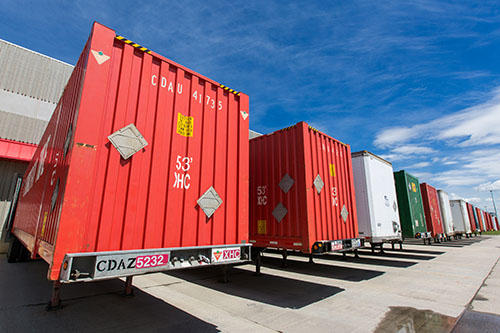The Goods Movement Strategy: Making Calgary stronger for businesses
Calgary is well positioned as an inland port and is a goods-distribution hub for local, provincial, national, and international markets. The City created a Goods Movement Strategy in 2018 to strengthen that position and guide transportation investment decisions over the next 30 years.
Real Estate and Development Services already creates ideally located
industrial parks that leverage Calgary’s transportation assets (road, highway, rail and air) to provide a smoother, more efficient flow of goods for all transportation modes. Overall, Calgary is
more cost-effective than Vancouver. The Goods Movement Strategy will help us upgrade and improve City transportation infrastructure to support existing businesses and attract new ones interested in Calgary’s advantageous location.
Who was involved?

The Goods Movement Strategy is the first of its kind for Calgary. The project used advisory groups and some public engagement to help us develop it. Advisory group members included regional partners and industry stakeholders such as the Calgary International Airport Authority, CN and CP rail, supply-chain management program educators, and goods companies like Sobeys and Shoppers Drug Mart. They provided us with feedback on operational improvements and assisted in developing a long-term strategic vision for Calgary.
Stakeholder input is reflected throughout the strategy, from the assessment of current conditions to the action items. More information about engagement for the project is within in the What We Heard reports.
The City also used research and technical analysis. A survey of truck drivers travelling around Calgary was conducted to understand their travel patterns. A study of nine North American cities was also conducted to understand their goods movement strategies, how they have or are planning to address issues, and any solutions they’ve developed.
What was the outcome?
The Goods Movement Strategy is made up of six strategic directions with 26 action items, which are divided into short, medium, and long-term groups. The strategic directions focus on:
- Continue strategic infrastructure investments
- Collaboration with external partners to enhance regional goods movement
- Promote planning for logistics centres and industrial areas
- Enhance last-kilometre deliveries
- Develop flexible plans to adapt for new and emerging technologies
- Enable data collection and research on goods movement
Examples of action items include:
- Review signal timings to enhance the flow of goods along key corridors
- Review and update the processes of land-use planning, site planning, corridor plans, etc. to make sure we’re prepared for new technologies
- Establish a goods movement committee, with representatives from the public and private sectors
- Improve access for employees in industrial areas
You’ll find all the action items and details in the Goods Movement Strategy Report.

Keep in touch
Receive regular listings, news, and information from The City of Calgary's Real Estate Development Services team.
Related articles

Categories: Municipal policy and processes

